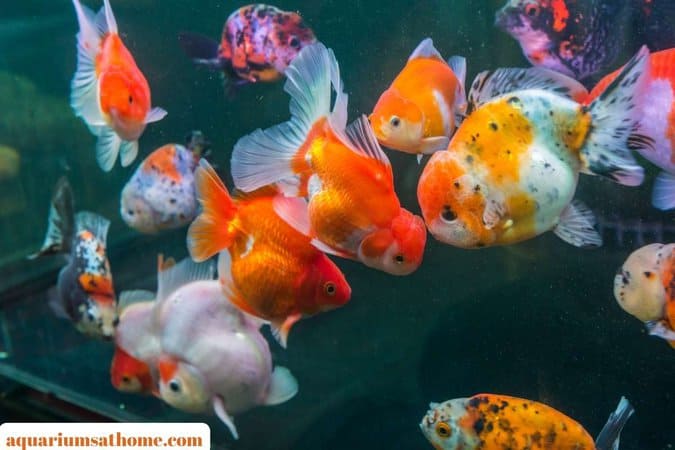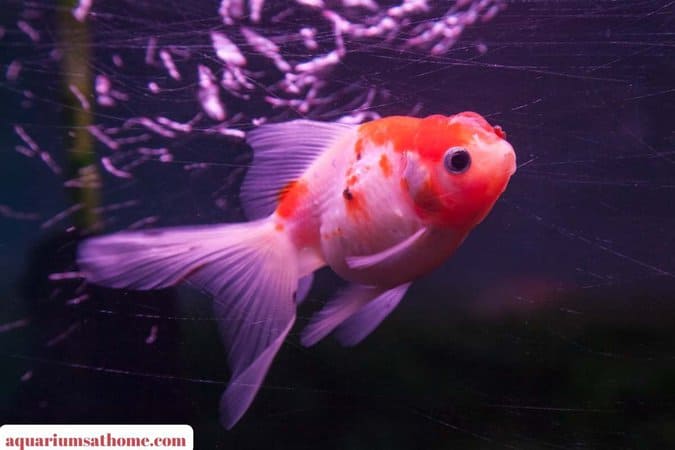Welcome to our comprehensive guide on Oranda Goldfish – an exquisite and captivating addition to any aquarium.
In this article, we will delve into the fascinating world of Oranda Goldfish, providing you with in-depth information about their origin, appearance, care requirements, and tips to create a thriving aquatic environment for these majestic creatures.
Without further adieu, let’s begin!
Understanding Oranda Goldfish
Oranda Goldfish, also known as “Red Cap” Goldfish, are a captivating variety of fancy goldfish that have captured the hearts of aquarists worldwide.
Originating from China during the Ming Dynasty, these stunning fish are renowned for their unique physical features, including a prominent, bumpy head growth known as a wen, which resembles a beautiful crown.
This distinguishing feature has led them to be affectionately called “flower of the water.”
Appearance
The most striking feature of Oranda Goldfish is their distinctive head growth, which develops as they mature. Initially, young Orandas may have a small, undistinguished wen, but with proper care and time, it can grow to impressive proportions, often covering the entire head region.
This wen comes in various colors, such as vibrant red, white, or even a mix of both, adding a regal charm to these aquatic beauties.
Their bodies are typically round and egg-shaped and they possess flowing double tails that gracefully trail behind them as they swim, enhancing their elegance and allure.

Setting Up the Perfect Aquarium
Creating an optimal environment is crucial for the well-being of your Oranda Goldfish. Follow these essential steps to set-up a perfect aquarium for your beloved pets:
1. Tank Size and Shape
Oranda Goldfish require ample space to thrive. A minimum of 30 gallons is recommended to ensure they have enough room to swim and grow comfortably.
Keep in mind that Orinda’s can reach a considerable size and providing them with a spacious environment will contribute to their overall health and happiness.
A rectangular tank is ideal as it provides better swimming space compared to rounded or bowl-shaped containers.
2. Water Quality
Maintaining pristine water quality is of utmost importance for the health of your Oranda Goldfish. These fish are sensitive to water conditions and poor water quality can lead to stress and various health issues.
Invest in a high-quality filtration system that can handle the tank’s capacity and perform regular water changes to keep ammonia and nitrite levels in check. Monitoring the water temperature is also crucial; Orandas thrive in temperatures between 65°F to 75°F (18°C to 24°C) for optimal comfort.
3. Substrate and Decorations
Choose a soft substrate such as fine gravel or sand to prevent injury to their delicate fins. Oranda Goldfish are natural foragers so a soft substrate will allow them to search for food without harming themselves.
Additionally, consider adding aquarium-safe decorations, plants, and hiding spots to the tank. These features will not only enhance the aesthetic appeal of the aquarium but also provide a stimulating and stress-free environment for your Oranda Goldfish to explore and play.
4. Compatible Tank Mates
Oranda Goldfish are generally peaceful and sociable but it’s essential to select compatible tank mates to avoid any potential conflicts. Avoid keeping them with aggressive or fin-nipping fish species as these can cause harm to their delicate fins and head growth.
Opt for other peaceful species that prefer similar water conditions such as other fancy goldfish varieties or peaceful community fish.
5. Water Parameters and Maintenance
Maintaining the right water parameters is essential for the well-being of your Oranda Goldfish. In this section, we’ll explore the specific water conditions they thrive in and provide tips for effective maintenance:
Water Parameters
Oranda Goldfish are sensitive to water quality so it’s crucial to monitor and maintain specific parameters:
- Temperature: Keep the water temperature between 65°F to 75°F (18°C to 24°C) for their comfort.
- pH Level: Maintain a pH level between 6.5 to 7.5.
- Ammonia and Nitrite: Regularly test and ensure that ammonia and nitrite levels are at zero.
- Nitrate: Keep nitrate levels below 40 ppm through regular water changes.
Water Changes
Frequent water changes are vital for keeping the aquarium environment pristine:
- Perform partial water changes (about 20%) every one to two weeks. After the tank has been setup for 6 months you can experiment with longer periods between water changes.
- Use a water conditioner to remove chlorine and chloramines from tap water.
- Vacuum the substrate during water changes to remove debris and uneaten food.
Filtration
As mentioned above, invest in a quality filtration system that matches your tank’s size:
- A canister filter or a sump filter is recommended for larger tanks. Larger would be anything 50-gallons or larger.
- I prefer a hang on back (or also called an HOB filter) for anything smaller than a 50-gallon tank.
- Ensure the filter is adequately cycled to support the biological filtration process.
6. Health and Common Issues
Oranda Goldfish, like all fish, can face health challenges. This section provides insights into their common health issues and how to keep your fish in top condition:
Common Health Problems
Be vigilant for these common health issues:
- Ich (White Spot Disease): Watch for white spots on the fish’s body, fins, or gills which may indicate this parasitic infection.
- Swim Bladder Disorder: Look for signs of buoyancy problems such as floating or sinking issues.
- Fin Rot: Monitor for frayed or disintegrating fins which may be a sign of bacterial infection.
Preventive Measures
Prevention is key to maintaining your Oranda Goldfish’s health:
- Quarantine new fish for at least a few days (although some hobbyists will say two weeks) before introducing them to the main tank.
- Avoid overfeeding as it can lead to obesity and health problems – less is more.
- Keep stressors such as sudden changes in water parameters to a minimum.
Feeding Your Oranda Goldfish
A well-balanced diet is essential for the health and vibrant coloration of your Oranda Goldfish. Here are some guidelines for their dietary needs:
1. High-Quality Pellets or Flakes
Offer a high-quality, sinking pellet or flake food specially formulated for goldfish. These foods are rich in essential nutrients and vitamins necessary for their well-being. Regularly check the food packaging for a balanced blend of proteins, fats, carbohydrates, vitamins, and minerals.
2. Fresh Vegetables
Supplement their diet with blanched vegetables like peas, lettuce, and spinach. Vegetables provide essential fiber and nutrients to aid in digestion. Before offering vegetables to your Orandas, blanch them to soften the texture and make them easier to consume.
3. Occasional Treats
Treat your Oranda Goldfish to occasional live or frozen foods like bloodworms, daphnia, or brine shrimp. These protein-rich treats add variety to their diet and mimic their natural feeding behavior. However, moderation is key – treats should be offered sparingly to prevent overfeeding and maintain a balanced diet.

Breeding Oranda Goldfish
If you’re interested in breeding Oranda Goldfish, it’s essential to understand the process and requirements:
1. Separate Breeding Tank
Prepare a separate breeding tank with ample hiding spots and gentle filtration. Oranda Goldfish prefer privacy during the breeding process and the presence of hiding spots will help reduce stress. Conditioning the potential breeding pair with a nutritious diet and maintaining pristine water conditions is crucial to ensuring successful breeding.
2. Identifying Breeding Behavior
During breeding, the male will chase the female, nudging her to release eggs which he will then fertilize. After spawning, remove the adult fish from the breeding tank to protect the eggs from potential predation. The eggs are adhesive and will attach to various surfaces in the breeding tank.
3. Caring for Fry
The eggs will hatch in a few days and the fry will initially absorb their yolk sacs for nourishment. Once they become free-swimming, feed them with finely crushed flake food or baby brine shrimp. Ensure that the fry have access to small, live food that suits their tiny size and helps them grow stronger and healthier.
Final Thoughts
In conclusion, Oranda Goldfish are magnificent aquatic creatures that can bring joy and serenity to any aquarium. By providing them with a well-maintained environment and a nutritious diet, you can ensure their health and longevity.
I hope this comprehensive guide has given you valuable insights into the world of Oranda Goldfish and assists you in creating an aquarium that showcases the splendor of these captivating fish.
Remember, every aquarium is a unique ecosystem – observing your Oranda Goldfish’s behavior and tailoring their care accordingly will lead to a rewarding and fulfilling experience as an aquarist. Happy fishkeeping!




